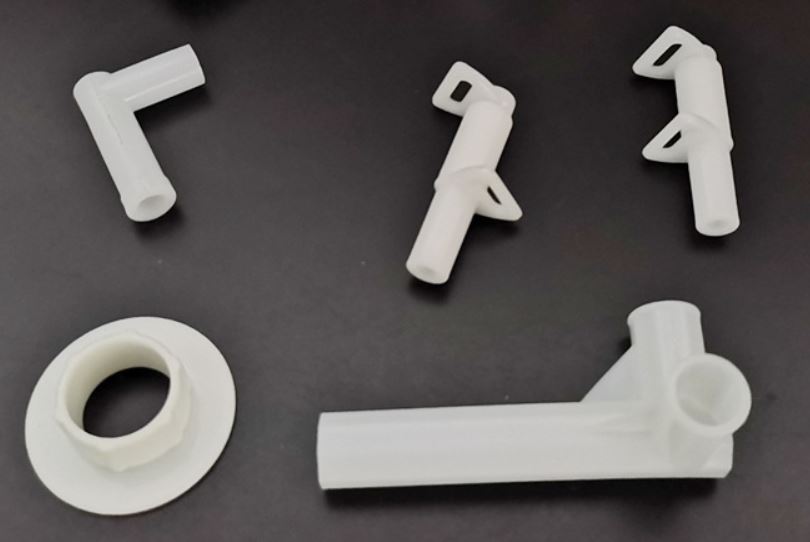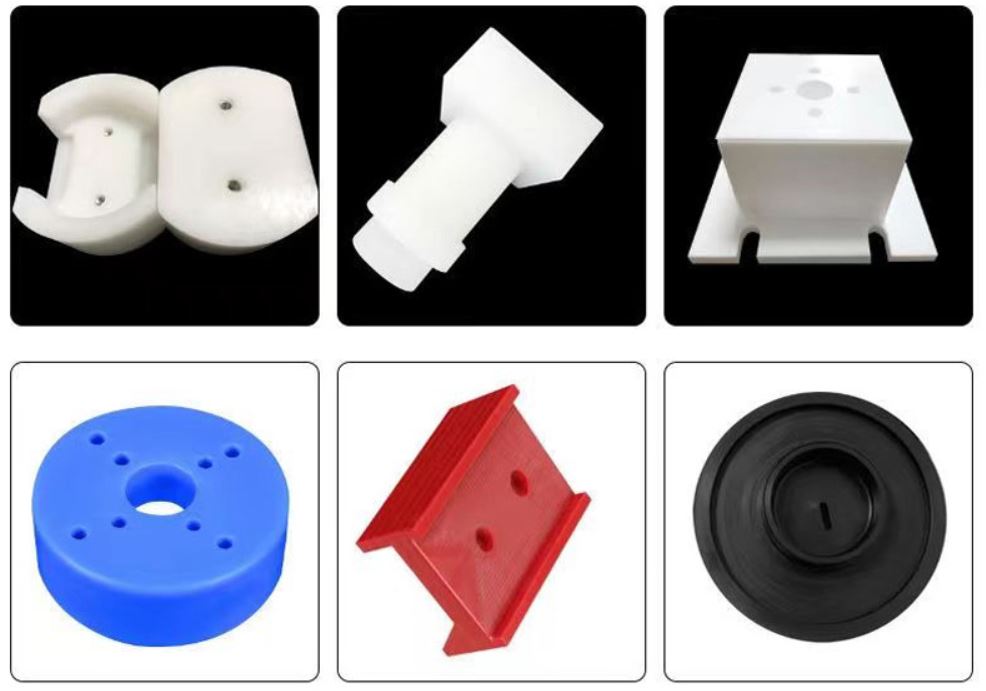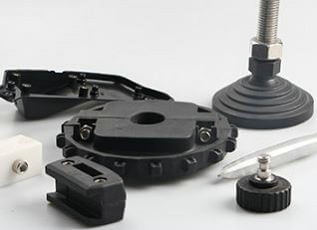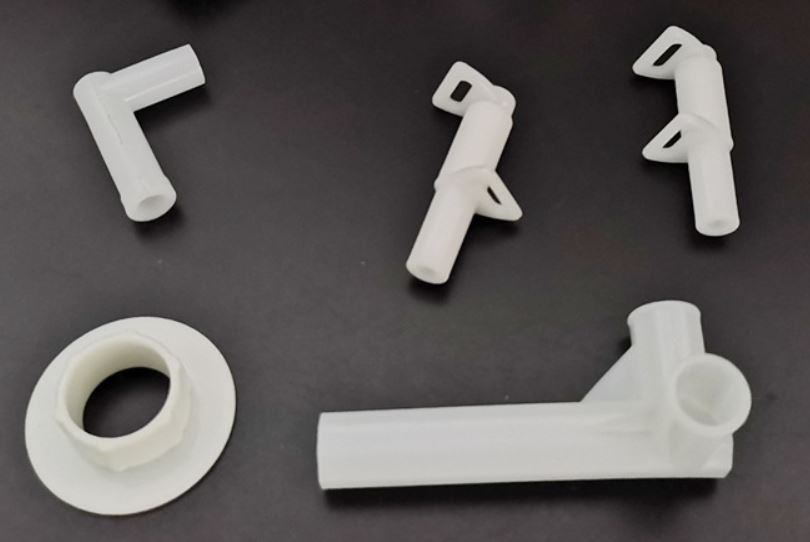Acetal injection molding or POM injection molding parts manufacturered from Polyoxymethylene (POM), a highly processed thermoplastic material. POM can take a homopolymer or copolymer acetal form. Homopolymer acetal exhibits high strength because of its crystalline structure. However, it can be problematic as a result of the highly specific melting point. Copolymer acetal is easier to mold due to the larger processing window. It is less mechanically strong than the previous material as its crystalline structure is less ordered.
Some renowned suppliers offer copolymer acetals. While DuPont, a well-reputed material provider offers only Delrin®, a homopolymer with enhanced properties. Delrin® grades are categorized according to their strength, stiffness, viscosity, and resistance. It is compatible with both injection molding and CNC machining. Acetal mold products/parts are vitally used in automotive, medical as well as fluid handling sectors.
This article primarily focuses on acetal plastic injection molding, POM properties, benefits, and design guidelines for fabricating parts from POM. Moreover, we will provide an Injection Molding Design Guide, certain suggestions, and recommendations for optimal outcomes for your acetal injection molding project.

What Is Acetal?
Acetal, which is also known as polyoxymethylene (POM), is a tough and high-performance thermoplastic. It’s a semi-crystalline material, commonly used for engineering applications. Acetal polymers are formed by the linking of long chains of the molecular formula CH2O. Some copolymer monomers are also incorporated to provide additional functionality. Depending on the structure, acetal can be a homopolymer or copolymer in nature depending upon the structure.
The best-known homopolymer acetal is DuPont™ Delrin®. Acetal plastics have a high strength and stiffness which make them ideal for applications that require high strength but low flexing. These plastics also possess low friction and high wear rates. Low water absorbency makes acetal possess excellent resistance to dimensional changes. For these reasons, acetal is used in place of metals for many uses.
Acetal/POM Material Properties
Table: Properties of various acetal grades
| Property | Delrin® 100 BK602 | Duracon® M90-44 | Celcon® M90 | Kepital® F20-03 | Hostaform® C9021 |
| Physical | |||||
| Density (g/cm³) | 1.42 | 1.41 | 1.41 | 1.41 | 1.41 |
| Shrinkage Rate (%) | 1.9–2.2 | 2.1–2.3 | 1.9–2.2 | 2.0 | 1.8–2.0 |
| Rockwell Hardness | 120 R | 80 M | NA | NA | NA |
| Mechanical | |||||
| Tensile Strength (MPa) | 72 | 62 | 66 | 65 | 64 |
| Elongation at Yield (%) | 23 | 35 | 10 | 10 | 9 |
| Flexural Modulus (GPa) | 2.9 | 2.5 | 2.55 | 2.55 | NA |
| Flexural Strength (MPa) | NA | 87 | NA | 87 | NA |
| Injection Molding | |||||
| Drying Temperature (°C) | 80–100 | NA | 80–100 | 80–100 | 120–140 |
| Drying Time (hrs) | 2–4 | NA | 3 | 3–4 | 3–4 |
| Melt Temperature (°C) | 215 | 200 | 205 | 180–210 | 190–210 |
| Mold Temperature (°C) | 80–100 | 80 | 90 | 60–80 | 85 |
The table above presents the POM trade names mentioned above together with their properties. Homopolymer Delrin® 100 has the highest tensile strength because of a higher degree of crystallinity in the polymer. POM is characterized by very good tensile and flexural strength but by a high rate of shrinkage. Depending on the application requirements certain POM grades may contain fillers to improve strength, corrosion, or UV resistance.
Pros of POM Injection Molding
Acetal has high performance with desirable engineering characteristics. The material offers high fatigue and creep strengths when subjected to stress. High mechanical strength makes it optimal for different precision-demanding sectors, like aerospace, and automotive. Low friction helps POM to have a very small level of wearing over a long period. Moreover, acetal does not rust/corrode and can also work at high temperatures.
Fatigue Resistance
Acetal injection molding parts has good performance characteristics when it is subjected to repetitive stress cycles. It is most appropriate in situations where the load bearing is constant such as gears. Thus, homopolymer POM provides better fatigue strength than copolymers do. These peculiar features make it possible to have long-term dependability in conditions of high stress. Strength in fatigue makes POM suitable for use in applications where mechanical parts are desired.
Creep Resistance
POM molded part exhibits dimensional stability when subjected to mechanical loads in the long term. It has a very low tendency to undergo permanent deformation, even when it is subjected to constant stress. This characteristic makes POM suitable for use in load-bearing applications. The material’s lack of creep also makes it ideal for structural applications. This is a very reliable area of the performance under pressure of POM.
High Strength
POM injection molding parts provides the best tensile and flexural characteristics. The material provides the rigidity required in high-performance mechanical parts. Homopolymer versions of POM show even greater strength as compared with the copolymers. Some common uses include conveyors and safety-related components. POM mechanical characteristics are quite versatile to allow various applications.
Low Friction
Low friction of POM decreases wear and tear in the sliding members. The material is well-suitable for use in areas where there a little movement variation involved. It requires minimal maintenance because of its natural tendency to reduce friction: This ability of POM to resist abrasion keeps the molding parts ‘ life quite long. Therefore, it is often applied where low friction is a necessity.
Food Safety
Advanced POM food-grade material meets safety standards applicable to food contact products. POM can also be used by manufacturers of food processing machinery and equipment. It has complied with the FDA, USDA, and all legal and regulatory requirements of strict safety. Due to its non-toxicity POM is well-suited to employ in these sectors. acetal injection molding part is widely used in food processing equipment for its reliability and dependability.
Dimensional Stability
Acetal injection molding products comprise accurate dimensions once they have cooled from the molding processes. During molding its shrinkage rate is relatively high but afterward, it remains almost uniform. Dimensional stability is important in sectors such as automotive and electronics. POM injection molding parts remain dimensionally stable during mechanical application and pressure. This characteristic is a prerequisite for precision components.
Corrosion Resistance
POM is relatively immune to most chemical agents such as fuels and solvents. It is best used in places that may come into contact with chemicals. For example, cylindrical storage tanks. However, the material is affected by strong acids and bases. POM stands up well to chemical attack and, therefore is the right material for use in fluid management. It also has good and stable chemical resistance as well as a long service life in harsh conditions.
Heat Resistance
POM is capable of enduring usage in areas that have high temperatures, up to 105°C. Homopolymer grades withstand higher heat bursts than copolymers do. The intended property is crucial for those components that are exposed to varying temperature conditions. This characteristic makes POM suitable for use in industries because of its tolerance to high temperatures. The right choice of materials used means the ability to withstand thermal climates. To high temperature plastic pgae to know more high temperature materials.

Key Considerations in POM Injection Molding Design
Injection molding acetal prefers the use of stainless steel molds. The material being used has a corrosive effect. Therefore the molds used must be strong and resistant. High shrinkage calls for a keen mold design to achieve precise parts. POM is widely applied in automotive, industrial, and medical parts. So, molding must be done in the right manner and in this case, it is going to ensure that the degree of precision and quality output is going to be high. It is important to take into account some features when designing for POM injection molding.
Wall thickness should be in the range of 0.030 and 0.125 inches. By maintaining thickness variation to the minimum, it is possible to achieve a uniform thickness of the part. The management of tolerances is crucial because the company’s rate of shrinkage is high, and this is evident from the case of POM. Radii should be minimized particularly in the regions that experience maximum stress. Draft angles ranging from 0.5 to 1 degree are ideal because their ejection is smooth.
Wall Thickness
The thickness of the wall has a direct influence on the quality of injection-molded POM parts. Thicker sections may also make the piece warp or shrink in some ways or the other and this may not be desirable. This way the overall structure is improved and one maintains consistent thickness. However, extremely thin walls though difficult must fall within certain limits. Wall thickness plays a vital role in structural applications and if well done, helps reliably to withstand high pressures.
Tolerances
POM exhibits high shrinkage which can become a challenge when working on POM molding parts that have to be within close tolerance. In particular, thicker walls are found to increase the probability of tolerance deviation. Designing to ensure equal measurements is not a bad idea as this will ensure that dimensions are consistent. There is always a way of properly molding and this would ensure that tolerances are within the acceptable limits. Problems due to dimensional changes are well managed by planning and control.
Radii
Radii in part designs help to minimize stress concentration in the use of the part. Sharp corners are always a problem because they are the points that can cause a structure to be less durable. By including radii these high-stress areas are minimised hence increasing the life of the part. Radii must be equal to or greater than 0.25 times the nominal thickness of the pipe wall. Smaller radii reduce stress; however, larger radii, up to 75% offer better stress distribution.
Draft Angle
It is possible to achieve high POM part ejection with minimal draft angles. POM has a low friction, it also has the possibility of having draft angles of 0.5 degrees. It is conceivable that for parts such as gears, zero drafts may not be essential to satisfy design specifications. Drafts help to avoid the difficulty of the separation of parts from molds with minimal or no harm. Good draft design enables efficient production and better quality of the part to be produced.
POM Material Processing Challenges
What makes POM difficult to process? Well, certain determinants decide its optimal functioning. As POM has a slight or low tolerance to high thermal conditions. Several factors are taken into consideration by mold operators during injection molding. Such factors are heat control, moisture level, molding parameters, and shrinkage. These elements are important to achieve successful production of high-quality POM injection molding parts.
Heat
One of the most critical aspects to be managed in POM injection molding is heat. When heated at a temperature higher than 210°C, the material undergoes thermal degradation. This breakdown results in the formation of by-products that are corrosive and end up affecting the injection mold. Mold temperature should be between 60-100°C for the best outcome. Further, the short heating cycles are also beneficial because they do not stress the material too much. With the increase in temperature, it should be accompanied by a decrease in residence time to achieve quality.
Moisture
The moisture absorption of POM is quite low and it lies between 0.2 to 0.5%. However, it is advised that POM resin should be dried before processing to get the best results. The drying time is normally between 3 to 4 hours, depending on the POM grade. This is important so that moisture levels are low during molding to decrease the occurrence of defects. Careful preparation avoids problems related to moisture during the injections.
Molding Parameters
The right molding parameter must maintained for POM injection molding. The successful injection pressure identified is between 70 to 120 MPa to ensure good repeatability of the experiment. A medium to high injection speed is also desirable to achieve a smooth production of the part. Molded part control requires proper parameter control to ensure that the molded parts meet specific specifications. By closely tracking these parameters it is possible to enhance the quality of the final product.
Shrinkage
Shrinkage is a usual problem with POM materials including Delrin®. Shrinkage rates are usually between 2 to 3.5 percent in the cooling stage of the cycle. The majority of shrinkage happens when the part is still in the mold, and the rest are during post-ejection. Non-reinforced homopolymer POM exhibits greater shrinkage than copolymer materials. These shrinkage rates must be considered in mold design to meet the desired dimensions.

Disadvantages of Acetal Injection Molding
Although acetal molding offers several benefits. It also has its limitations and drawbacks. In addition, acetal molds come with many challenges. These limitations must be carefully considered during the molding process for companies to achieve good-quality end-use products.
Poor Weather Resistance
Acetal is highly vulnerable to degradation. Normally, in situations when it’s exposed to ultraviolet light or UV light. This is so because constant exposure to them can cause major color shifts and eventually affect their performance. UV deteriorates the aesthetic value and physically weakens the material. Moreover, UV radiation strips the structure of polymers away. Hence, there must be use of stabilizers to enhance acetal’s resistance to weathering. These stabilizers may not prevent the degradation fully over long periods outdoors thus hampering the use of acetal in exterior uses.
Brittleness
In its solid state, Acetal is highly resistant and possesses high stiffness, but undergoes brittle failure under special circumstances. Temperature Low temperature affects the material characteristic of acetal and makes it prone to crack or fracture when experiencing an impact. However, this brittleness is a drawback in any applications where high-impact strength is desirable, particularly at low temperatures. There are significant challenges in designing products that are molded from acetal so that they can endure shock without fracturing.
Concerning the effects of the acetal molding process on the mechanical properties of parts, considerations should be taken into account.
Acetal Injection Mold Design
When designing an application using acetal material it is important to get the mold right because it determines the quality and stability of the end product. Here are some key design guidelines to follow:
- Runner Diameter: The runner diameter is suggested to be between 3 and 6 mm to enable easy flow of the material during injection.
- Gate Length: Ideally, the gate length should be some 0.5mm to provide proper regulation of the throughput of the material. It improves the uniformity of the mold so that no defects are formed when filling the mold with the material.
- Round Gate Diameter: This should be between half and six times the thickness of the part being molded. By sizing the gates properly it eliminates cases like short shots and weld lines.
- Rectangular Gate Width: By design, the width of the rectangular gates must measure at least twice the thickness of the product. This should ideally be about 0.6 times the wall thickness as far as the structural reinforcement of the vessel is concerned.
- Draft Angle: A mold angle of 40 to 1 30 is proposed for straightforward removal of the molded part without any abrasion on the surface.
Pre-Drying Acetal Material
Even if it has a high moisture absorption value, the acetal part is suggested to be pre-dried before injection molding for the resin. Pre-drying also reduces the presence of some form of moisture that is destructive like the formation of voids or bubbles. The drying process should be at a temperature of 80–100°C and should take 2-4 hours. Correct drying is as important since it assists in retaining various characteristics of the materials besides facilitating guzzle-free molding.
Acetal Molding Temperature Control
When it comes to acetal injection molding it is very crucial to maintain both moisture and melt temperature for enhanced results. The mold temperature should be maintained between 75 and 120 centigrade and the melt temperature to be between 190 and 230 centigrade (374 and 446 Fahrenheit respectively). Parameters such as accurate temperature regulation also manage problems like distortion shrinkage or even poor surface finish. Accurate regulation of thermal conditions helps to cool uniformly and, therefore, minimize stresses when improving the dimensional characteristics of the final product.
Injection Pressure
Each material requires a specific injection pressure that needs to be attained to provide the specific part quality. The pressure range is in the range of 40–130 MPa depending on the melt flow rate of acetal and the thickness and sizes of the runner gate and part. When pressure is low, the mold can be filled inadequately, and if pressure is high, then there is likely to be flash or other defects. The optimum pressure is important for the creation of appropriate part formation and the exclusion of defects.
Injection Molding Speed
The injection speed is also another that greatly influences the process of acetal molding. Depending on puddle formation, mold injection speed ranges from moderate to fast to avoid defect creation as the mold is filled. In case of slow speed, the flow marks or surface imperfections are seen on the surface. On the other hand, high speed may lead to what is called jetting or shear overheating which is bad for the strength and surface finish of most parts. Through modification of the injection speed, one can be able to eliminate the molding defects as well as enhance the molding productivity.
These considerations allow manufacturers to enhance the efficiency of their acetal injection molded parts by controlling parameters, and issues incurred. To make the best use of the positive attributes of acetal while avoiding its drawbacks, certain aspects of mold design, material handling as well as the process must be finely tuned.
Conclusion
Acetal or polyoxymethylene is a type of injection-molded semi-crystalline thermoplastic. This material is commonly used in mechanical parts such as bushings, bearings, gears, and sprockets.
Compared to metals and other plastics acetal has a low friction coefficient and high rigidity. These features greatly improve its wear properties, and thus the resultant products are long-lasting.
Altogether these characteristics make acetal a material of choice for many engineering applications. The proper processing and design of the equipment improve their efficiency and durability in different industries.
Introducing acetal into production processes may result in higher efficiency and lower frequency of maintenance of mechanical equipment.



